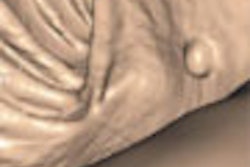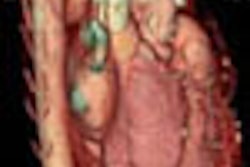In yet another document that may influence hospitals and other entities responsible for credentialing the future performance of cross-sectional cardiac imaging, a host of societies dominated by cardiologists has come out with guidelines as to what training and experience should be required.
Compared to the standards issued one month earlier by the American College of Radiology (ACR), the new ones from the American College of Cardiology Foundation (ACCF) and the American Heart Association (AHA) are more detailed and require more procedural volume for maintenance of competence.
On the other hand, the cardiology guidelines appear to set aside the issue of interpreting the noncardiac anatomy visible on cardiac MR or CT scans. Under the new CPT codes going into effect January 1, 2006, physicians are responsible for interpreting any pulmonary nodules, abnormal mediastinal lymph nodes, or other pathology visible on the axial 2D source images.
The "ACCF/AHA Clinical Competence Statement on Cardiac Imaging With Computed Tomography and Magnetic Resonance" was published in July in leading cardiology journals (Circulation, July 26, 2005; Vol. 112: 4, pp. 598-617, and Journal of the American College of Cardiology, July 19, 2005; Vol. 46:2, pp. 383-402).
Other groups that helped with and/or signed off on the guidelines include the American Society of Echocardiography, the American Society of Nuclear Cardiology, the Society of Atherosclerosis Imaging, the Society for Cardiovascular Angiography and Interventions, the Society for Cardiovascular Magnetic Resonance, and the new Society of Cardiovascular Computed Tomography.
The guidelines assume that practitioners have already completed a cardiovascular fellowship or a residency in nuclear medicine or general radiology.
Additional training in cardiac MR or CT is then recommended at three levels: Level 1 for introductory training, Level 2 as a minimum for independent practice, and Level 3 for serving as the director of a cross-sectional cardiac imaging service.
Looking at Level 2, the one most practitioners would be aiming for, the guidelines for cardiac MR competence would require three months of training and completion of 150 cases. Continuing experience of 50 cases or more per year would be expected, along with 30 hours of continuing education coursework in the modality every three years.
The cardiac CT competence guidelines vary slightly from that model, requiring eight weeks of training and 200 cases (or just four weeks and 150 cases for noncontrast exams only). Continuing experience of 50 cases or more per year and 20 hours of CME every three years is also recommended.
By Tracie L. Thompson
AuntMinnie.com staff writer
August 2, 2005
Related Reading
New CPT codes set for coronary CT angiography, July 26, 2005
ACR sets standards for noninvasive cardiac imaging, June 6, 2005
ACC, ACR debate stats on imaging growth, April 18, 2005
U.S. Congress hears debate over federal imaging standards, March 17, 2005
Cardiac CT societies merge, as field's golden age dawns, March 9, 2005
Copyright © 2005 AuntMinnie.com




















